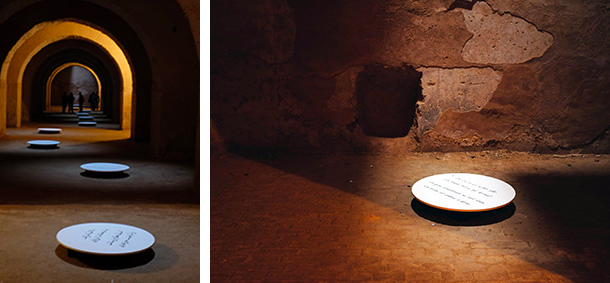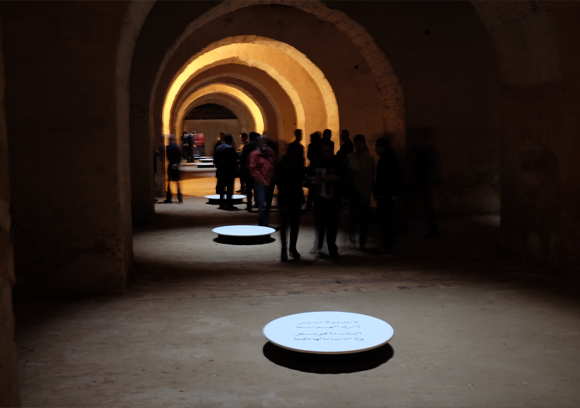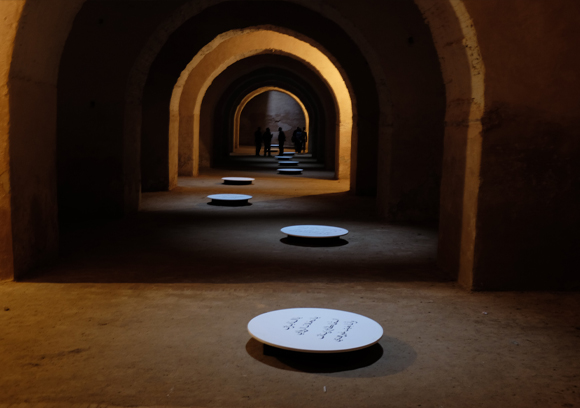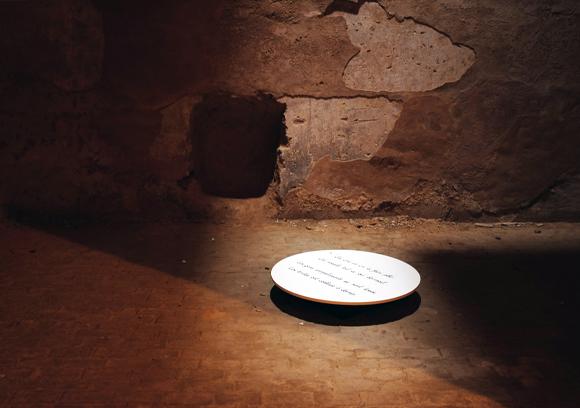| |
|
|
57.
| It is still Nightfall |
| |


2015, wooden circle and calligraphy, poem from Al Majdoub.
Exhibition view of C'est encore la nuit, Prison Qara - Institut Français de Meknés, 2015, Meknés.
Courtesy of the artist and Analix Forever, Geneva.
Ed. of 5 + 1 A.P.
'' mounir fatmi discovered this place, he learned that this prison had become a place of freedom for the youth of Meknes who often come here as couples and carve their love into the walls.
He therefore chose to use these halos of light that provide a breath of air to this prison to create his installation.
It’s still Nighttime is made up of 80 circles placed under the rays of light from the openings. ''
Florence Renaut-Darsi, April 2015

It is still Nightfall
Exhibition view of C'est encore la nuit, Prison Qara - Institut Français de Meknés, 2015, Meknés.
Courtesy of the artist.

It is still Nightfall
Exhibition view of C'est encore la nuit, Prison Qara - Institut Français de Meknés, 2015, Meknés.
Courtesy of the artist.

It is still Nightfall
Exhibition view of C'est encore la nuit, Prison Qara - Institut Français de Meknés, 2015, Meknés.
Courtesy of the artist.
|
|
|
|
|
|
L'installation C'est encore la nuit se tient dans la légendaire prison de Qara à Meknès (Maroc). C’est une vaste geôle souterraine et labyrinthique, construite au dix-huitième siècle à la demande du sultan Moulay Ismail. Elle se compose de 80 disques de bois peints en blanc et couverts d'inscriptions calligraphiées de couleur noire, extraites des quatrains du poète soufi Sidi Abderrahman el Majdoub, très populaire au Maroc et dans tout le Maghreb, et dont les poèmes ont fourni de nombreux proverbes passés dans la langue courante. Les disques sont disposés sous les halos de lumière tombant depuis les oculus de la prison - à la fois systèmes d'éclairage et d'aération destinés aux prisonniers et aux esclaves des lieux.
C'est encore la nuit interroge le rapport de l'observateur contemporain au monde à l'aide de la notion de quête mystique présente dans la doctrine soufi (à la fois recherche du divin et exploration du moi profond), à partir de la mise en relation d'éléments du patrimoine culturel appartenant à des époques différentes, et en faisant enfin dialoguer entre elles poésie et architecture. Projet photographique et installation sont comme les deux faces d'une même démarche artistique. L'installation en constitue la version nocturne : elle met en scène l'intérieur du bâtiment plongé dans la pénombre et presque entièrement coupé de l'extérieur, une nuit prolongée, sans alternance ni fin, où tout repère temporel a disparu.
Ancrée dans le décor de la prison Qara, l'installation élabore une esthétique de l'enfermement et du cloisonnement qui rappelle la description de la situation initiale du sujet en quête de soi, telle qu'elle est présentée dans la doctrine soufi. Séparé d'avec lui-même et de ses désirs, la recherche du moi profond est une tentative pour l'individu de se rejoindre et d'appréhender le monde dans toute sa réalité, et ce en dehors de ses catégories de pensée habituelles qui constituent un empêchement. La recherche est une aventure souterraine, dans les profondeurs de l'esprit et de l'existant. Elle est une quête labyrinthique et l'accès à la pleine conscience est un parcours difficile et jalonné d'obstacles nombreux. La question de l'accès aux connaissances et au savoir est ainsi par la même occasion directement reliée à celle de l'accès à la liberté. Les effets de clair-obscur obtenus grâce à la lumière tombant des puits, le faible éclairage des lieux, le fait que les conditions de visualisation de l'œuvre dépendent entièrement de la course du soleil et le mince apport en oxygène faisant craindre la suffocation ajoutent au mystère et viennent dramatiser en la rendant cruciale la question de l'accès au savoir. La répétition rigoureuse des motifs circulaires et leur apparition régulière sur le chemin emprunté par les spectateurs évoque l'ascèse à laquelle le mystique doit se plier afin d'atteindre l'unité tant recherchée.
Cheminement ascétique donc, mais également subversif : les espaces sont détournés de leur fonction carcérale première. La présence en ces lieux - historiquement dédiés à la censure et à l'enfermement des contestataires - des quatrains sulfureux du poète révolutionnaire constitue une licence évidente. Elle est la manifestation d'un désir à l'œuvre dans toute quête de soi et de liberté, désir qui se nourrit d'obstacles tout en s'en affranchissant avec légèreté. De nos jours, les couloirs de la prison servent d'ailleurs de lieux de rendez-vous clandestins pour les amoureux qui gravent sur les murs leurs déclarations enflammés. L'installation fait dialoguer architecture et poésie, lieu de mémoire inamovible quasiment éternel et parole éphémère et poétique porteuse de désirs. Elle donne à lire une forme de revanche historique : celle du poète, des amoureux et du désir sur l'histoire, la politique, l'architecture et leurs pouvoirs d'enfermement, de censure ou d'empêchement. L'œuvre incite au déplacement et propose d'aller à la rencontre du monde, des autres et de soi-même à partir de sources d'inspirations mêlant philosophie et poésie, rigueur intellectuelle et sensibilité.
Studio Fatmi, Septembre 2015.
|
|
The installation It’s Still Nigthfall is held in the legendary Qara prison in Meknès, Morocco, a large underground and labyrinthine jail built in the 18th century at the request of sultan Moulay Ismail. The installation comprises 80 wooden disks painted in white and covered in calligraphed black inscriptions taken from quatrains by the Sufi poet Sidi Abderrahman el Majdoub, who is very popular in Morocco and across North Africa and whose poems are the source of many commonly used proverbs. The disks are placed under the halos of light falling from the prison’s oculi that provided light and ventilation for the prisoners and slaves who populated it.
It’s Still Nightfall questions the relation of the contemporary viewer to the world by using the notion of the mystical quest found in the Sufi doctrine (in the sense of both a quest for the divine and an exploration of one’s inner self) based on the connection of elements of cultural heritage belonging to different historic periods, and also by creating a dialogue between poetry and architecture. The photographic project and the installation are like two facets of a single artistic process. The installation is its nocturnal version: it features the inside of the building in the dark and almost entirely cut off from the outside world – an extended night, without any alternation or end, from which all markers of time have disappeared.
Within the setting of the Qara prison, the installation elaborates an esthetic of imprisonment and isolation that is reminiscent of the description of the initial situation of the subject on a quest to find oneself as presented in the Sufi doctrine. Isolated from oneself and one’s desires, the quest for inner self is an individual’s attempt to rejoin himself and apprehend the world in all its reality, outside of the usual categories of thought that prevent this process. This quest is an underground adventure, in the depths of the spirit and of what exists. It is a labyrinthine quest, as accessing full consciousness is a difficult journey rife with obstacles. At the same time, the question of the access to knowledge is directly connected to that of accessing freedom. The chiaroscuro effects obtained from the light falling from the oculi, the dim lighting of the space, the fact that the conditions in which the work can be seen are entirely dependent on the course of the sun and the poor ventilation creating a fear of suffocation all add to the mystery and dramatize the question of the access to knowledge. The rigorous repetition of the circular motifs and their regular appearance on the path followed by the viewers is evocative of the asceticism the mystic must abide by in order to reach the unity he seeks.
Thus, this is an ascetic journey, but also a subversive one: the spaces are diverted from their primary function as a jail. The presence in this place, historically dedicated to the censorship and imprisonment of dissenters, of the inflammatory quatrains by the revolutionary poet constitute a blatant form of licentiousness. It is the manifestation of a desire that can be found in every quest for self and for freedom, a desire that is fueled by obstacles while freeing itself from them with levity. Today, the prison corridors are used as a clandestine meeting place for lovers who etch their passionate declarations of love in the walls. The installation creates a dialogue between architecture and poetry, between an irremovable and almost eternal place of memory and ephemeral and poetic words filled with desire. It can be seen as a form of historic revenge: that of the poet, of lovers and of desire over history, politics, architecture and their capacity to imprison, censor and impede. This work encourages moving around and going out to encounter the world, other people and oneself through the combination of various sources of inspiration bringing together philosophy and poetry, intellectual rigor and sensitivity.
Studio Fatmi, September 2015. |
|
|
|